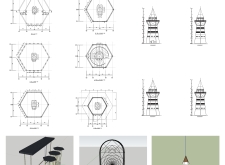5 key facts about this project
The primary function of the Kurgi Observation Tower is to offer a space for observation and recreation. Its design spans multiple levels, accommodating various activities such as sightseeing, gathering, and educational programs. A central feature of the design is its hexagonal form, which promotes efficient use of space while allowing for an unobstructed view from the upper observation deck. The use of large windows on higher levels ensures a seamless connection between the interior and exterior, enhancing the visual experience of users.
The structure comprises several key components that contribute to its overall functionality and design integrity. The ground floor serves as the main entrance and includes open spaces designed to welcome visitors and provide orientation within the tower. As visitors ascend through the multiple levels, they encounter a series of smaller, well-defined areas that encourage intimate interaction with the vistas.
The unique design elements set the Kurgi Observation Tower apart from other observation structures. Its combination of traditional and modern architectural features reflects the local context while embracing contemporary design practices. The structure is tapered, leading to a pointed roof that contributes to its unique silhouette. The extensive use of wood for the roof and some interior finishes pays homage to regional building traditions, while large glass panels allow for natural light and expansive views, creating a pleasant environment for visitors.
The integration of environmentally sensitive systems, including heating and cooling solutions, enhances the usability of the tower throughout the year. This approach to design not only addresses comfort but also reinforces the project’s commitment to sustainability and ecological responsibility.
Visitors are encouraged to explore the architectural plans, sections, and designs of the Kurgi Observation Tower for a comprehensive understanding of its concept and execution. This project provides valuable insights into modern architectural design while celebrating the cultural heritage of its location. By reviewing these elements, readers can appreciate the careful consideration given to every aspect of this tower's development.























